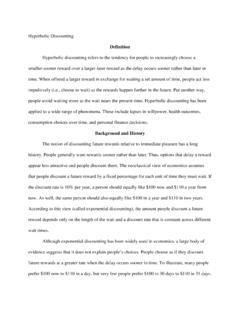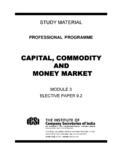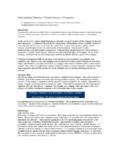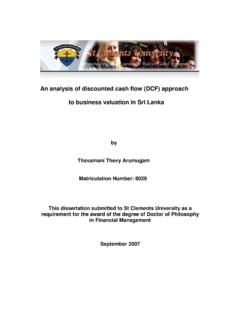Transcription of 2. TIME VALUE OF MONEY - University of Scranton
1 13 2. time VALUE OF MONEY Objectives: After reading this chapter, you should be able to 1. Understand the concepts of time VALUE of MONEY , compounding, and discounting . 2. Calculate the present VALUE and future VALUE of various cash flows using proper mathematical formulas. Single-Payment Problems If we have the option of receiving $100 today, or $100 a year from now, we will choose to get the MONEY now. There are several reasons for our choice to get the MONEY immediately. First, we can use the MONEY and spend it on basic human needs such as food and shelter.
2 If we already have enough MONEY to survive, then we can use the $100 to buy clothes, books, or transportation. Second, we can invest the MONEY that we receive today, and make it grow. The returns from investing in the stock market have been remarkable for the past several years. If we do not want to risk the MONEY in stocks, we may buy riskless Treasury securities. Third, there is a threat of inflation. For the last several years, the rate of inflation has averaged around 3% per year.
3 Although the rate of inflation has been quite low, there is a good possibility that a car selling for $15,000 today may cost $16,000 next year. Thus, the $100 we receive a year from now may not buy the same amount of goods and services that $100 can buy today. We can avoid this erosion of the purchasing power of the dollar due to inflation if we can receive the MONEY today and spend it. Fourth, human beings prefer to get pleasurable things as early as possible, and postpone unpleasant things as much as possible.
4 We can use the $100 that we receive today buy new clothes, or to go out for dinner. If you are going to get the MONEY a year from now, you may also have to postpone all these nice things. Then there is the uncertainty of not receiving the MONEY at all after waiting for a year. People are risk-averse, meaning, they do not like to take unnecessary risk. To avoid the uncertainty, or the risk of non-payment, we would like to get the MONEY as soon as possible. Banks and thrift institutions know that to attract deposits from investors, they must offer some kind of incentive.
5 This incentive, the interest, compensates the depositors for their inability to spend their MONEY immediately. For instance, if the bank offers a 5% rate of interest to the depositors, the $100 today will become $105 after a year. Introduction to Finance 2. time VALUE of MONEY _____ 14 Let us look at the problem analytically. If we deposit a sum of MONEY with the present VALUE PV in a bank that pays interest at the rate r, then after one year it will become PV(1 + r).
6 Let us call this amount its future VALUE FV. We may write it as FV = PV (1 + r) We may also think of (1 + r) as a growth factor. Continuing this process for another year, compounding the interest annually, the future VALUE will become FV = [PV (1 + r)](1 + r) = PV (1 + r)2 This gives the future VALUE after two years. If we can continue this compounding for n years, the future VALUE then becomes FV = PV (1 + r)n ( ) The above expression is valid for annual compounding.
7 If we do the compounding quarterly, the amount of interest credited will be only at the rate r/4, but there will also be 4n compounding periods in n years. Similarly, for monthly compounding, the interest rate is r/12 per month and the compounding occurs 12n times in n years. Thus, the above equation becomes FV = PV (1 + r/12)12n At times, it is necessary to find the present VALUE of a sum of MONEY available in the future. To do that we write equation ( ) as follows: PV = FV(1 + r)n ( ) This gives the present VALUE of a future payment.
8 discounting is the procedure to convert the future VALUE of a sum of MONEY to its present VALUE . discounting is a very important concept in finance because it allows us to compare the present VALUE of different future payments. Equations ( ) and ( ) relate the following four quantities: FV = the future VALUE of a sum of MONEY PV = the present VALUE of the same amount r = the interest rate, or the growth rate per period n = number of periods of growth If we know any three of the quantities, we can always find the fourth one.
9 Introduction to Finance 2. time VALUE of MONEY _____ 15 Multiple-Payment Problems In many financial situations, we have to deal with a stream of payments, such as rent receipts, or monthly paychecks. An annuity represents such a series of cash payments, even for monthly or weekly payments. Another example of an annuity is that of a loan that you take out and then pay back in monthly installments. Many insurance companies give the proceeds of a life insurance policy either as a lump sum, or in the form of an annuity.
10 A perpetuity is a stream of payments that continues forever. In this section, we will learn how to find the present VALUE and the future VALUE of an annuity. If there is a cash flow C at the end of first, second, period, then the sum of discounted cash flows is given by S = C1 + r + C(1 + r)2 + C(1 + r)3 + .. n terms ( ) Here S represents the present VALUE of all future cash flows. We compare it to the standard form of geometric series S = a + ax + ax2 + ax3 +.















